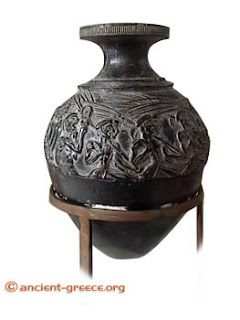Statue of The Maize God
The Maize God, Hun Hunahpu, is a personification of abundance and prosperity and creator of man. The head is unusually large for the body and some have suggested that the statue may have been portions of two statues affixed together as a "restoration".Source: British Museum
Maya Relief of Blood Letting
This relief depicts a blood letting ritual in Yaxchilan, Shield Jaguar the Great (King of Yaxchilan) is pulling a thorny rope through his wife's tongue. The Glyphs give the date (24 October, 709 AD), location, and names of those on the relief.
Source: British Museum
Jade Plaque of Mayan King
This Mayan plaque is notable because it was found in Teotihuacan (the capital of the Aztec empire), which shows that there was some form of contact between the Aztec and Maya. The plaque depicts a highly decorated Mayan ruler seated on a throne and a groveling figure genuflecting in the lower left.
Source: British Museum
Gold Pendant
This gold pendant is a likeness of an unknown Mayan ruler. Metalworking technologies were introduced to the Maya from further south, approximately modern day Panama, the Mayans appeared to have a trade relationship with the peoples of the are as their metalwork is strewn throughout Mayan territory.
Source: British Museum
Fenton Vase
Polychromatic Ceramics such as this one were highly regarded in Mayan culture and considered to be a sign of high status. These vessels have been integral to studying Mayan society as they are essentially annotated snapshots of Mayan life. This scene, for example, is a depiction of a Mayan giving tribute to a lord. The Glyphs give the names of all the people depicted, strongly implying that this was an actual event.
Source: British Museum
Mayan Wall Painting
This is the first Mayan wall art ever to be discovered, found in the ruined city of Xultun. The level of decay is as high as much older Egyptian wall art because humidity is much higher in the Yucatan than he deserts of Egypt.
Source: Huffington Post
Stone Head
This head came from Copan, which is famous for its of sculptures. This head was part of the mysterious Structure 20, which was destroyed by the raging river Copan. It is speculated that this head was once a part of of a statue of a cross legged figure.
Source: British Museum
Crystal Skull
This crystal skull is a forgery, but both the Aztec and the Maya made crystal skulls. We know this one to be a forgery because it was built with rotary cutting wheels, which were introduced to the new world after the Maya died out by the spanish, and because the material was obtained in the 19th century.
Source:British Museum
Shell Ornament
This ornament is made from the shell of the Red Rimmed Thorny Oyster. These shell ornaments were common in Mayan society. These shells were also used as funerary adornments.
Source: British Museum
Jade Portrait Head Inscribed with Glyphs
This mask was carved from a single block of jade, the glyphs have been partially eroded, but it still supplies interesting information. The text reveals little, but mentions a person in some way associated with the Mayan city Palenque. From this, historians have inferred that this belonged to the mother of Yax Pac (the ruler of Copan), who brought it with her to Copan from Palenque as an heirloom. This is but one of a whole host of possibilities, and the mask remains a mystery.
Source:British Museum














blah%5B6%5D.jpg)

























